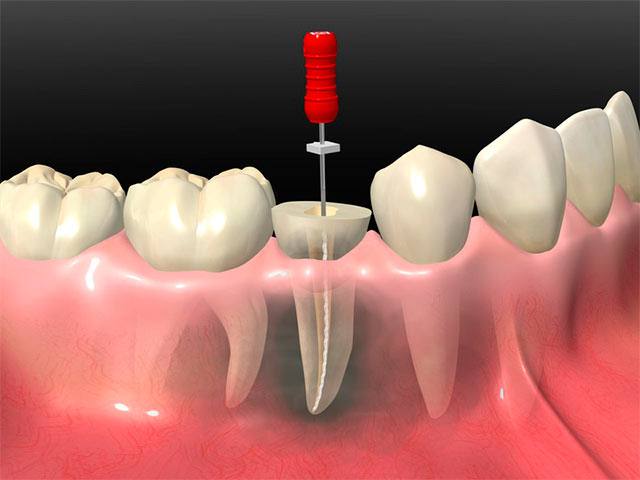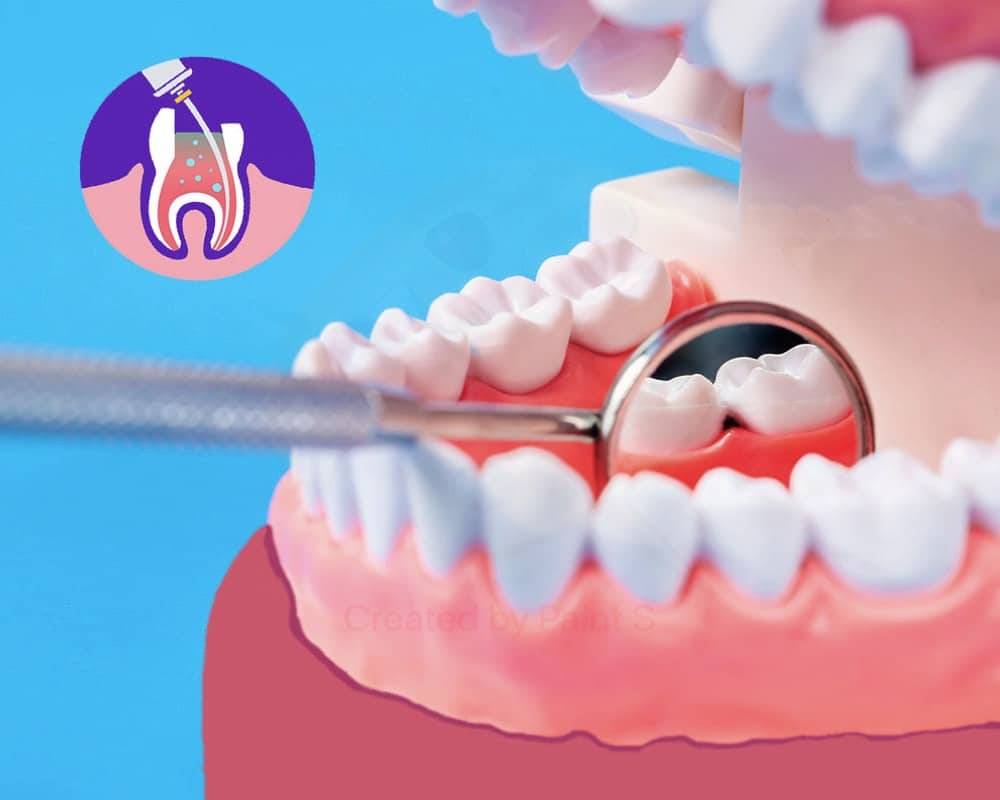Contact us
Our schedule
Odonto Stetic Dental Clinic
Endodontics
What is Endodontics?
Endodontics is the removal of the dental pulp (nerve) from inside the tooth, when it becomes inflamed or infected.
This may be due to different causes: Deep caries, trauma, fractures, previous dental treatments, etc.
The treatment is carried out with special instruments called files and disinfecting liquids.
Subsequently, the inside of the tooth is filled so that there are no empty spaces that allow infections.
It is a completely painless procedure, since it is performed under local anesthesia, or even without anesthesia, in some cases, when it is a chronic process.
Generally, endodontic treatment is performed in a single session, and there will be slight discomfort the two or three days after. The discomforts usually disappear with pain relievers.

Our specialties
We offer painless endodontics
Endodontics
● Dental microscope: It allows the visualization of areas of the tooth, impossible to see exclusively with the human eye.
The operating microscope has become essential to magnify and illuminate imperceptible areas with the naked eye, which is why the results and prognosis of Endodontic treatment are much better.
● Mechanical and rotary instrumentation: It allows a better cleaning and conformation of the tooth canal.
● Digital radiology: It allows much lower radiation doses to be used, as well as enlarging the image as much as desired.
● Electronic apex locator: Essential to accurately determine the length of the dental roots.
● Dental tomography: It allows to accurately reconstruct the dental anatomy and its possible alterations.
● Rendodontia: In those cases in which Endodontics fails, either by inadequate prior technique, by anatomical alterations, or by germs not eliminated.
● Apical microsurgery: It is performed when the previous Endodontics fails, and the only way to access the inside of the tooth is through the gum. Performing under a microscope allows minimal surgeries and considerably increases their success.
● Revascularization: In definitive teeth of children, when the formation of the same has not finished. It allows the complete formation of the root of these teeth.
How is an Endodontic performed?
This treatment is performed with local anesthesia, which will not be painful. We will proceed to eliminate the tissue where the caries is, then it will eliminate the nerve, cleaning it very carefully and it will shape to facilitate filling the canal and finally it will proceed to seal it so that it is well closed.
Most common types of endodontics
Keep in mind that each mouth is different therefore each mouth will have a different treatment. There are three types of root canals and they are as follows:
● Single root canal: It is usually performed on the anterior teeth since its main characteristic is that they only have one canal.
● Biradicular endodontics: This endodontics is performed on teeth with more than one canal, that is, on premolars.
● Polyradicular endodontics: These root canals are performed in particular on the molars, since they have three or more nerves or roots.
Our Clients Say
I can only thank you for everything you have done for me and my family, close and honest treatment coupled with great professionalism. The price is neither expensive nor cheap, neither is it a bargain nor is it impossible, a visit is highly recommended.
ENDODONTIC TREATMENT
Frequent questions Endodontics
Endodontic treatment is necessary when the dental pulp becomes inflamed or infected. This can occur from various causes: deep caries, trauma or fractures to the tooth and other pathological processes that may affect the tooth. If the inflammation or infection of the pulp is not treated, intermittent or constant pain may occur, and sometimes a phlegmon (with swelling of the gum of the oral mucosa) or a fistula (with suppuration) may appear.
Signs of a damaged pulp include: pain, prolonged sensitivity to cold or heat, discoloration, and swelling and discomfort in the gums around the tooth. Sometimes there are no symptoms.
Endodontic treatment could also be recommended for teeth that require carving for the subsequent placement of crowns or fixed bridges.
In most cases, pulp treatments can be performed in one session. However, each patient will be evaluated independently and we will decide, depending on their situation, if any other measure is required.
After such therapy, the properly restored and treated tooth is no longer fragile. In the case of posterior teeth (premolars and molars), it may be convenient to protect the crown of the tooth (the visible part, which protrudes from the gum) by means of suitable reconstructions, for a greater durability of the same.
The clinical and radiographic examination is performed first. Next, local anesthesia is administered. A rubber dam is then placed to keep the tooth isolated, clean, and free from contact with saliva during the procedure.
Next, an opening is made in the crown of the tooth to access the conduits where the pulp is located. Instruments and a disinfecting irrigating solution are used to clean the pulp from the root canals. These are then filled with a biocompatible material, usually gutta-percha with a cement, to ensure complete sealing of the ducts. Finally, a temporary or definitive restoration is placed (“filling” or reconstruction of the opening made and of the portion of the crown that may need it).
These treatments are painless, since today very effective and long-lasting local anesthetics are used.
During the first days after treatment, you may notice sensitivity or discomfort on the tooth, due to postoperative inflammation of the tissues surrounding the tooth.
You should try not to chew or bite with the treated tooth until the final restoration of the tooth is performed ("filling" or reconstruction).
It is essential not to delay the restoration of the teeth excessively after root canal treatment to avoid any complication or fracture of the same.
It is important that you visit your dentist periodically (at least, an annual review) to avoid the appearance of cavities or other factors that could influence the prognosis of the treated tooth. Which, will behave the same as the others both in its function and in its duration, requiring the same hygiene care, prevention and periodic reviews as any other tooth.
OUR TEAM
Professionalism, rigor, seriousness and closeness

Dr. William Eljadue Lopez

Carolina Martinez Ortiz

Sandra Navarro Tapia
Start your Treatment
Come and meet us without commitment
PATIENTS
Our Patients Say
I can only thank you for everything you have done for me and my family, close and honest treatment coupled with great professionalism. The price is neither expensive nor cheap, neither is it a bargain nor is it impossible, a visit is highly recommended.
My son's orthodontics was a success, a case that nobody wanted to treat because of how difficult it was after 2 and a half years ends with a real success. Great professionals and better people.
After doing many laps and having a major health problem in my mouth, I have managed to find some real professionals, from the beginning they gave me confidence and tranquility. The truth is that I did many laps before meeting them and it was a gift for me to find the doctors and their entire team.
Discover the Latest News of the Sector
Our blog

¿ES MEJOR UN PUENTE DENTAL O IMPLANTES DENTALES?




